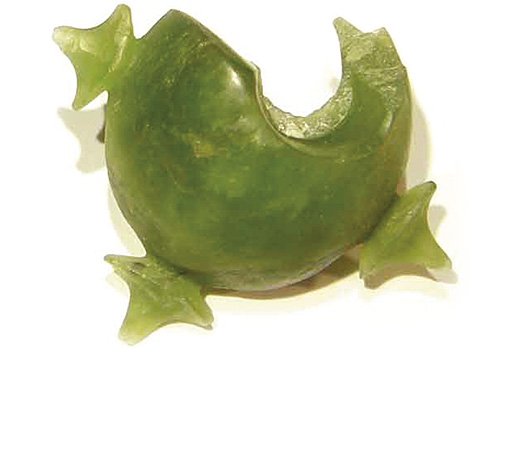Cultural Center of the Philippines
ENCYCLOPEDIA OF
PHILIPPINE ART
[Jade lingling-o with three budlike projections]
Ca 500-300 BCE / Early Metal Age / Uyaw Cave, Lipuun Point, Quezon, Palawan, Philippines / Taiwan green nephrite / Length 2.95 cm, width 2.3 cm, thickness 1.6 cm, weight 10 g / Inv. no. 62-Z-61 / National Museum of the Philippines collection
From 2000/1500 BCE to CE 500, green jade artifacts—bracelets, adzes, and beads—came by sea from eastern Taiwan into Batanes, Luzon, and Palawan, among other regions. During the end of this period, artisans in Batanes and Batangas recut imported green jade artifacts into ear ornaments (Belwood et al. 2011, 30-41). These emerged as prestige goods in the more southern regions of Island Southeast Asia during the Early Metal Age (500 BCE-CE 500), suggesting a long-distance trade that spanned 2,500 years.
The story of jade in the Philippines begins with a bracelet fragment of green nephrite from Fengtian deposits in eastern Taiwan, likely shaped in Taiwan but found in the Neolithic site of Nagsabaran, Cagayan Valley (1800/1500 BCE). When high-ranking Taiwanese turned away from using jade for status and began favoring metal, glass, and carnelian beads around 1500 BCE, jade working appears to have moved to Ludao and Lanyu islands (southeastern Taiwan), the Philippines and, later, Batanes. Recent archaeological work in Batanes has yielded a small jade adze with black inclusions (likely Fengtian) from Sunget, Batananda workshop of Fengtian jade in Anaro, Batanes, the latter inhabited between 1000 BCE and recent centuries.
While Fengtian jade came to the Philippines during the Neolithic (4000/3000 to 500 BC), Fengtian lingling-o appeared largely during the Early Metal Age (500 BCE- CE 500). The Tabon Cave complex excavations headed by Robert B. Fox in the 1960s, for example, yielded no less than 18 green jade lingling-o ear ornaments in Duyong Cave and 14 in Uyaw Cave. Fox (1970) called those with three lotus-bud-like projections “Sa Huynh type” and those with four projections “Hong Kong type.” He also noted that debris from the cutting and drilling of nephrite in Batangas reflected a technology that the Maori of New Zealand employed on their own jade.
With all excavated green jade ear ornaments in Island Southeast Asia thus far originating from Fengtian in the Central Mountain Range (near Taiwan’s Hualian city), a workshop of Fengtian jade found in Anaro, Batanes, and Fengtian jade lingling-o excavated in Palawan, Sarawak, southern Vietnam, and, possibly, Thailand and Cambodia, archaeologists have focused on jade to better understand this ancient regional ancient trade network (Hung et al. 2005). It is important to note that Filipino craftsmen refashioned these ear ornaments and innovated this technology, the latter adopted by the Maori of New Zealand centuries later. Also of interest is that archaeologists in the 1990s began to call these jade ear ornaments lingling-o in direct reference to identically shaped cast metal ornaments that highlanders in northern Luzon continue to produce and use today.
Written by Purissima Benitez-Johannot
Sources
Bellwood, Peter, Hsiao-Chun Hung, and Yoshiyuki Iizuka. 2011/2012. “Taiwan Jade in the Philippines: Three Thousand Years of Trade and
Long-Distance Interaction.” In Paths of Origins: The Austronesian Heritage in the National Museum of the Philippines, Museum
Nasional Indonesia, and the Rijksmuseum voor Volkenkunde, edited by Purissima Benitez-Johannot, 30-41. Manila; Singapore: ArtPostAsia.
Fox, Robert B. 1970. The Tabon Caves. Manila: National Museum Monograph 1.
Hung, Hiao-Chun, and Yoshiyuki Iizuka. 2005. “Archaeomineralogy of Taiwan Nephrite: A Sourcing Study of Nephritic Artifacts from the
Philippines.” Journal of Austronesian Studies 1:35-81. National Museum of Prehistory, Taidong, Taiwan.
Ronquillo, Wilfredo P. 2012. “Lingling-o with Three Buds (Sa Huynh Type).” In Paths of Origins: The Austronesian Heritage in the National Museum of the Philippines, Museum Nasional Indonesia, and the Rijksmuseum voor Volkenkunde, edited by Purissima Benitez-
Johannot, 120-121. Manila; Singapore: ArtPostAsia.
